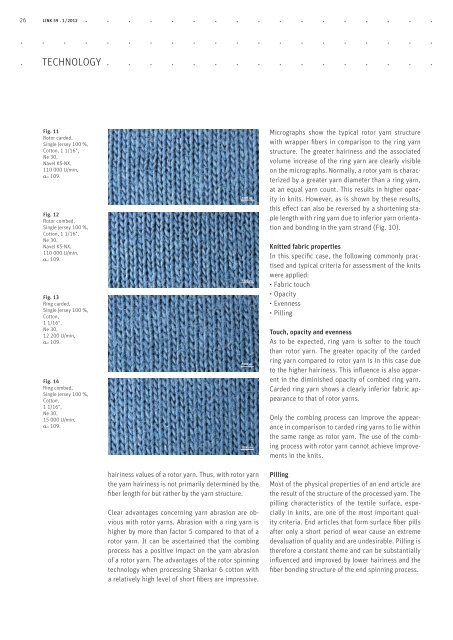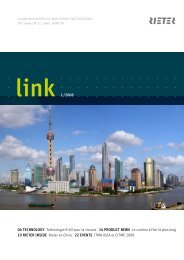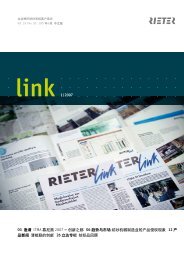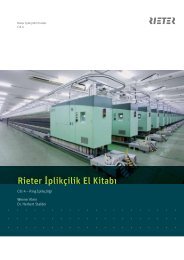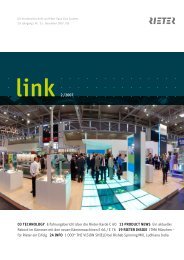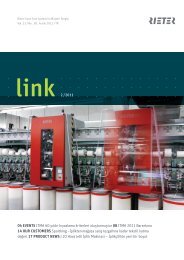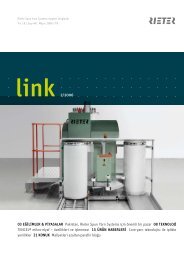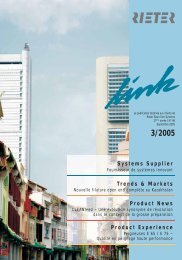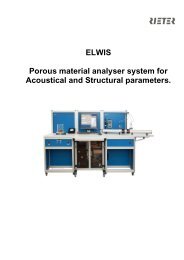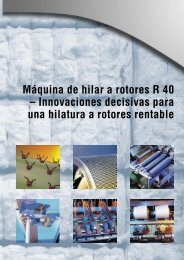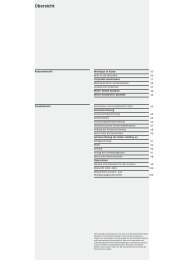link no. 59 customer magazine spun yarn systems - Rieter
link no. 59 customer magazine spun yarn systems - Rieter
link no. 59 customer magazine spun yarn systems - Rieter
You also want an ePaper? Increase the reach of your titles
YUMPU automatically turns print PDFs into web optimized ePapers that Google loves.
26 LINK <strong>59</strong> . 1 /2012<br />
TECHNOLOGY<br />
Fig. 11<br />
Rotor carded,<br />
Single Jersey 100 %,<br />
Cotton, 1 1/16",<br />
Ne 30,<br />
Navel KS-NX,<br />
110 000 U/min,<br />
αm 109.<br />
Fig. 12<br />
Rotor combed,<br />
Single Jersey 100 %,<br />
Cotton, 1 1/16",<br />
Ne 30,<br />
Navel KS-NX,<br />
110 000 U/min,<br />
αm 109.<br />
Fig. 13<br />
Ring carded,<br />
Single Jersey 100 %,<br />
Cotton,<br />
1 1/16",<br />
Ne 30,<br />
12 200 U/min,<br />
αm 109.<br />
Fig. 14<br />
Ring combed,<br />
Single Jersey 100 %,<br />
Cotton,<br />
1 1/16",<br />
Ne 30,<br />
15 000 U/min,<br />
αm 109.<br />
hairiness values of a rotor <strong>yarn</strong>. Thus, with rotor <strong>yarn</strong><br />
the <strong>yarn</strong> hairiness is <strong>no</strong>t primarily determined by the<br />
fiber length for but rather by the <strong>yarn</strong> structure.<br />
Clear advantages concerning <strong>yarn</strong> abrasion are obvious<br />
with rotor <strong>yarn</strong>s. Abrasion with a ring <strong>yarn</strong> is<br />
higher by more than factor 5 compared to that of a<br />
rotor <strong>yarn</strong>. It can be ascertained that the combing<br />
process has a positive impact on the <strong>yarn</strong> abrasion<br />
of a rotor <strong>yarn</strong>. The advantages of the rotor spinning<br />
tech<strong>no</strong>logy when processing Shankar 6 cotton with<br />
a relatively high level of short fibers are impressive.<br />
Micrographs show the typical rotor <strong>yarn</strong> structure<br />
with wrapper fibers in comparison to the ring <strong>yarn</strong><br />
structure. The greater hairiness and the associated<br />
volume increase of the ring <strong>yarn</strong> are clearly visible<br />
on the micrographs. Normally, a rotor <strong>yarn</strong> is characterized<br />
by a greater <strong>yarn</strong> diameter than a ring <strong>yarn</strong>,<br />
at an equal <strong>yarn</strong> count. This results in higher opacity<br />
in knits. However, as is shown by these results,<br />
this effect can also be reversed by a shortening staple<br />
length with ring <strong>yarn</strong> due to inferior <strong>yarn</strong> orientation<br />
and bonding in the <strong>yarn</strong> strand (Fig. 10).<br />
Knitted fabric properties<br />
In this specific case, the following commonly practised<br />
and typical criteria for assessment of the knits<br />
were applied:<br />
• Fabric touch<br />
• Opacity<br />
• Evenness<br />
• Pilling<br />
Touch, opacity and evenness<br />
As to be expected, ring <strong>yarn</strong> is softer to the touch<br />
than rotor <strong>yarn</strong>. The greater opacity of the carded<br />
ring <strong>yarn</strong> compared to rotor <strong>yarn</strong> is in this case due<br />
to the higher hairiness. This influence is also apparent<br />
in the diminished opacity of combed ring <strong>yarn</strong>.<br />
Carded ring <strong>yarn</strong> shows a clearly inferior fabric appearance<br />
to that of rotor <strong>yarn</strong>s.<br />
Only the combing process can improve the appearance<br />
in comparison to carded ring <strong>yarn</strong>s to lie within<br />
the same range as rotor <strong>yarn</strong>. The use of the combing<br />
process with rotor <strong>yarn</strong> can<strong>no</strong>t achieve improvements<br />
in the knits.<br />
Pilling<br />
Most of the physical properties of an end article are<br />
the result of the structure of the processed <strong>yarn</strong>. The<br />
pilling characteristics of the textile surface, especially<br />
in knits, are one of the most important quality<br />
criteria. End articles that form surface fiber pills<br />
after only a short period of wear cause an extreme<br />
devaluation of quality and are undesirable. Pilling is<br />
therefore a constant theme and can be substantially<br />
influenced and improved by lower hairiness and the<br />
fiber bonding structure of the end spinning process.


